At Moreton Telegraph Station.
We eased our way into Moreton over several weeks until the owners departed, leaving us on our lonesome. It was a good way to do it as initially it seemed like there was an awful lot we had to do as caretakers, but now after we have been here for a little over 3 months the expectations are far from onerous. They just seemed that way until we got to know the place & established a routine.

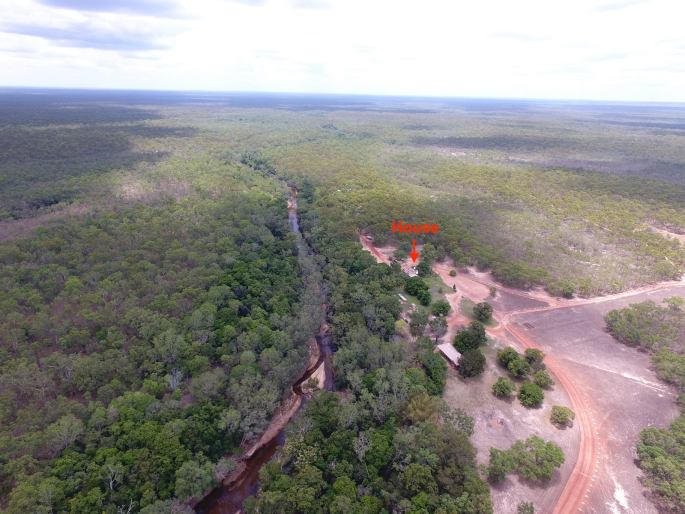
Shortly after getting back here, the place was still open to campers, & we learned from a couple who had just come down from Captain Billy’s Landing that the south easterly winds had dropped away. A clear sign of the changing season & a good reason to make a second visit to this beautiful place in order to experience it without the incessant wind & rain. It was not to be unfortunately. We had taken our car to Weipa to get the leaking swivel hubs sorted, but the job had been poorly done (the apprentice was blamed) & it was leaking again by the time I had got back to Moreton, necessitating a return trip to get it rectified. At the same time we had discovered a small payment made with our credit card which we had not made. Contacting the bank confirmed that our card had been compromised & the card was cancelled. No big deal but trying to get the car sorted, & to deal with the bank, & inability to make online purchases for a few things we needed all added up to feel big in the context of trying to wrap our heads around the requirements of our new location. A weak excuse perhaps, but it felt enough to get sorted out without taking a few days to go back to Captain Billys. I think partly our heads were in a ‘stopping’ space after a few months of ‘going’.


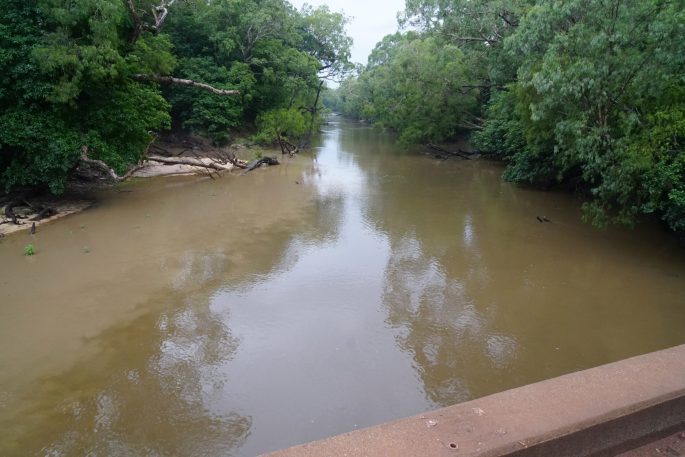
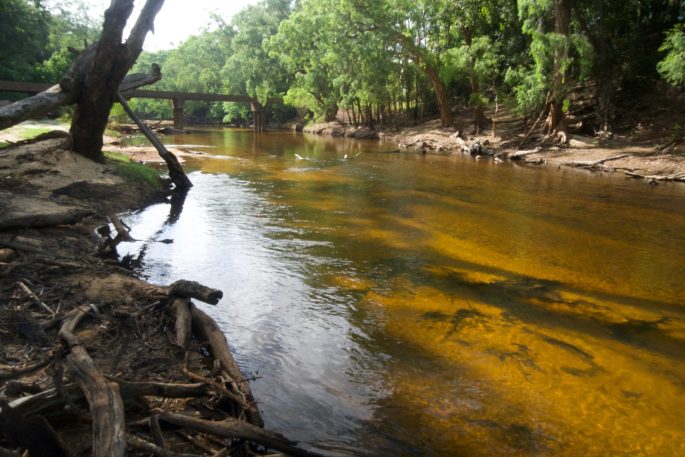
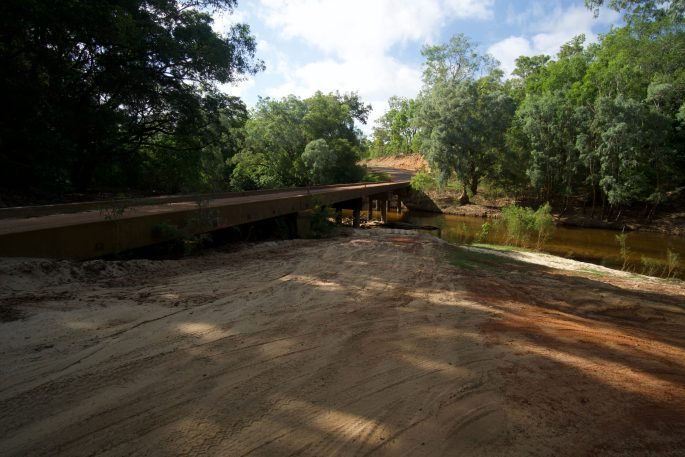
Moreton Telegraph Station today operates as a popular campground for Cape travellers during the tourist season, the only campground with lush green grass on the cape. Back in the days of morse code Moreton was a residence for some of the men who kept the only means of communication between Australia & the rest of the world maintained & operational. In those days it was a rough & isolated place but has become more civilised in modern times. Although the old telegraph line is no more, the property remains a government owned station, which until fairly recently was leased on an annual basis. Mike & Wendy have had the lease & established the campgrounds since the early 90’s, but now have greater tenure with a relatively new ’tourism lease’ for 30 years. With this more secure tenure comes greater reason to invest in infrastructure, so we think it likely the place will see a number of upgrades over the next few years. That said we have all the comforts of home here. A basic furnished house with power, water, internet, Tv & phone. The latter 3 via satellite. Power is from a diesel generator which runs 24/7, water is pumped from the river though filters throughout the dry season, & rainwater used during the wet season.
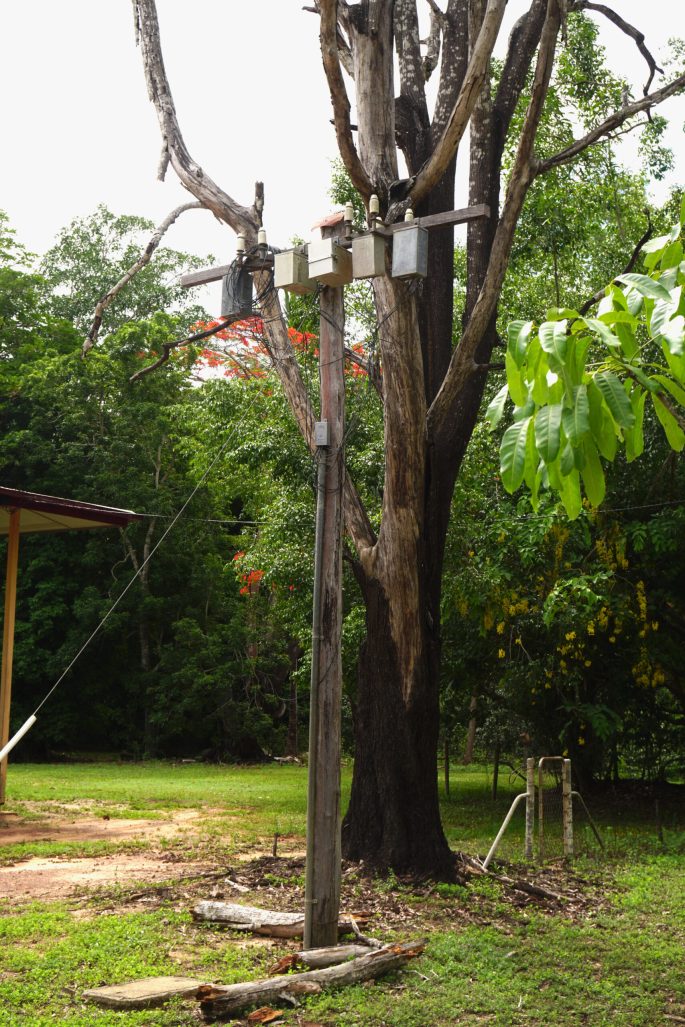

This is ‘home’ for the 6 to 7 months whilst the place is closed from early October through to April or May when closed roads should be able to re-open.
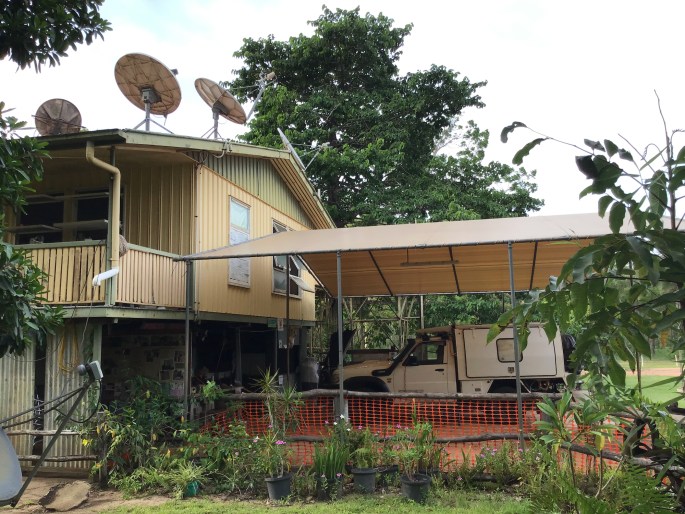




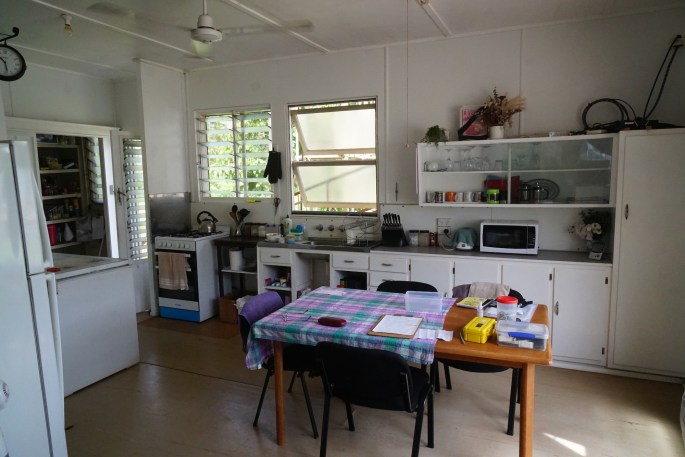

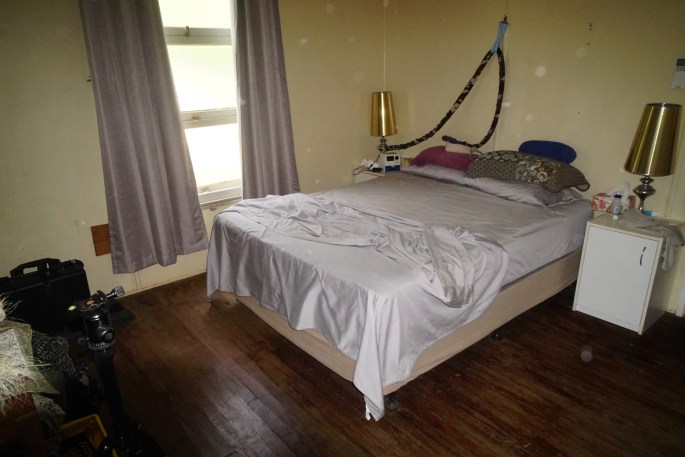


At time of writing (late January) we have not been cut off yet. We do expect that to occur, possibly for several months, depending upon the season. Further south on the Cape rivers have risen & fallen already, temporarily cutting roads, but here the bridge over The Wenlock River has yet to be inundated. When it is we will be unable to drive southward at all, & will only be able to drive northward for about 15kms as far as Schramm Creek which will likely cut the road too. In that 15kms stretch there is only bush. So at some point we will be completely physically isolated.
Road trains carry supplies up the Cape until Christmas, or until the road closes to heavy vehicles. It is now restricted to vehicles of 5 tonnes or less. Any rain makes the red dirt mushy & slippery. Road trains would do enormous damage in those conditions.
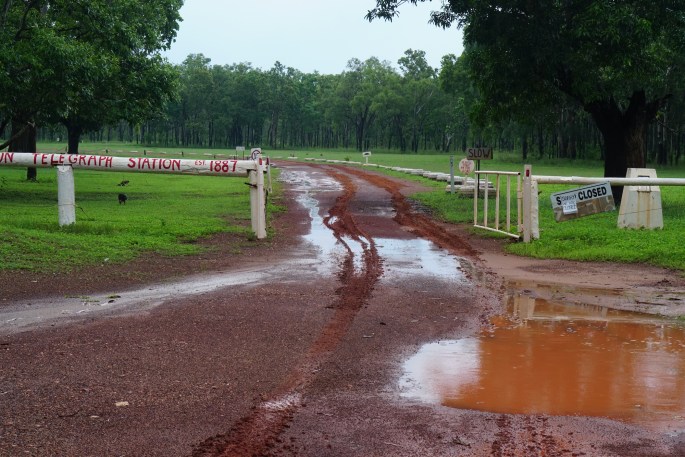
Whilst freight was still able to be carried we, together with the owners, had to put together our wet season supplies order. No ’nipping down the shops for a carton of milk or a bag of sugar here!
In addition to the supplies already here we had a frozen meat order, a dry & canned goods order & a variety of other household bits & pieces to last us for a 6 month period. Never before have we had to work out our needs for such a long period. All was delivered & the freezers filled, plus shelving erected in the spare bedroom where all the dried goods etc would be stored in the relative cool of constant air conditioning. We were told this is necessary for the hot & humid conditions which can spoil unopened goods & cause beer to go flat in the bottle. We call the spare bedroom our ’supermarket’ – it’s constant 20 deg C feels like walking into a fridge – occasionally we visit the ’supermarket’ even when we don’t need anything! 🙂
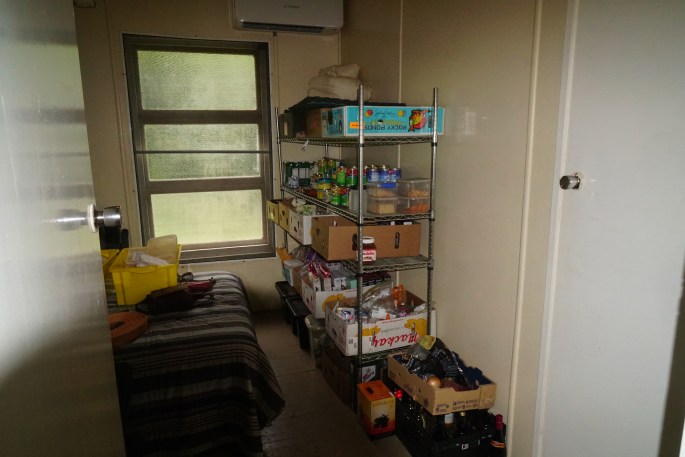

Of course fresh produce cannot be stored for 6 or 7 months. There is a neat way to deal with this though, & in part was one of the reasons we felt happy to take on the role here. The government subsidised (RASS – ‘Remote Air Services Subsidy’ scheme) mail plane lands here on our airstrip weekly, & we can put in a weekly order to the IGA supermarket 800kms south at Mareeba) 6 days in advance, & the plane brings it with any mail. Fruit & veg are chilled, wrapped, & sent in sealed polystyrene boxes, as are items which go soft (even in the air conditioned room) like crackers & biscuits. Unfortunately the weekly plane doesn’t always come weekly, weather, mechanical problems & mysterious ‘operational issues’ have been reasons, but this was predicted & the reason we also have a quantity of frozen veg in the freezers. As well as all our food, the owners also needed to get bulk diesel delivered before their departure, enough to keep the generator running for our time here. This was delivered by another road train with three tanker trailers, & decanted into 1000 litre IBC containers as well as filling a 2500 litre steel tank. In all we got 9500 litres & a 205 litre (44 gallon) drum of petrol. Providing for our stay was a costly exercise for the owners who didn’t bat an eyelid at doing so. We think they had also expected to pay us but we felt feeding us was plenty sufficient for the experience of being here.

We both did short online courses to become ARO’s (Aerodrome Reporting Officers) and to be able to access the comprehensive remote drug & medication chest supplied by the RFDS (Royal Flying Doctor Service). If circumstances dictate we can call the RFDS doctor to consult & be given authority to use a variety of medications, including scheduled drugs. The RFDS can also evacuate us by plane from here if needed. The ARO stuff was about maintaining the airstrip to minimum standards, knowing what to do & how to communicate with the pilot if for example a night time emergency landing were required or a bunch of feral bulls decided to engage in a bout of biffo in the middle of the airstrip as a plane was due to land.






Maintaining the airstrip is a weekly task. The mail plane day is Wednesday. Tuesdays have been renamed – Termite Tuesdays. The air strip itself is 900 metres long (plus an overshoot distance at each end), & approximately 300 metres wide. Every Tuesday we spend 2 or 3 hours walking the length & width of the strip de-homing millions of tiny termites, by crushing their building efforts of the past week with our boots. They are industrious little creatures, which if left to their own devices would build concrete like structures 5 metres high, but getting them on a weekly basis their construction efforts are still small & soft, & easily crushable, albeit numerous. We also check for holes etc created by wildlife – so far we have had none , but if there are we need to fill them to keep our mail from getting too shaken as the plane lands. 😉 On Wednesday morning another visit is made to the strip (about a kilometre from the house) for another safety check, including a 40kph drive down the strip in the Toyota (the ‘Moreton Ute’) & a safety report emailed to the airline before 7am. One of us has to remain in the house awaiting a call (no mobile service here) from the airline to inform us of the plane’s ETA. Generally it comes between 11am & 2.00pm, & we get to the airstrip 30 minutes before it is due, just in case any wildlife (feral cattle, wild pigs, roos, & even on one occasion a large dingo) needs chasing away. Mainly the worst wildlife however are the Black Flies, nasty little buggers with a painful bite, worst, it seems, after rain. The airstrip is our ‘lifeline’ to the outside world. It allows us to shop online! Ha ha.

We have other tasks, both regular & ‘as needed’. We take take daily readings of the river level & the rainfall. This info is submitted to the Bureau of Meterology before 9am. The result of this can be seen at
http://www.bom.gov.au/cgi-bin/wrap_fwo.pl?IDQ60296.html#Cape_Rivers_(East)
Scroll down to 2nd last section for ‘Wenlock R at Moreton’- that’s us.
Every 3 days we refill the generator’s fuel tanks. It’ll run for almost 4 days, but every three days avoids risk of it running dry. Although a modern unit (Kubota) amazingly it has no priming mechanism meaning if it runs dry all fuel lines need disconnecting to be filled individually with fuel squirted into them before it can be restarted. We needed to do this once before Mike & Wendy departed & it was a pain. 1000 litres of fuel in an IBC with a hose & nozzle attached is used. For reasons beyond me, even though the generator has connections which can take fuel direct from the IBC it wont work reliably. Probably not such a bad thing, it’s easier to remember refilling every 3 days than every 3 or 4 weeks. Every 10 or 11 days (250 hours) the generator oil needs changing & at 500 hours the oil & fuel filters need changing too. This is a pretty straightforward affair, but during which the generator is of course switched off, & the property has no power. A few things are kept running from a 12v battery bank via an inverter during this period (phones, computer & internet), & the house has mainly 12v lighting in case the generator should fail at night. These batteries are kept charged with a 240v charger when the generator is running. When switching the generator back on, various circuits need to be switched on in order, & a couple of appliances (a big old chest freezer & a water pressure pump) need to remain switched off until everything else is running & then switched on one at a time to prevent a spike in current draw which causes the generator to have a hissy fit & switch itself off. Gaining an understanding of this & other systems (eg water) was all part of the initial learning curve, contributing to what felt like ‘a lot’ but which isn’t once the understanding has occurred.





There are a couple of other generators at the Outback Spirit (A tour company) camp elsewhere on the property which need a weekly run to keep the cabin air conditioner units operational. They are older generators which use a bit of oil, so I keep a check on the oil levels too. The tropical climate plays havoc with appliances which are not used. Until a couple of years ago Moreton’s power used to shut down each night, but since they went to 24 hour power they have found that things like air conditioners, freezers & fridges have far longer lives than those switched on & off regularly.

Slashing the airstrip & tracks on the property with the tractor has also been a learning curve for me. I had driven an old ‘Grey Fergy’ once years ago, & more recently had had a go on the old Fiat Super 1000 at Mareeba on one occasion, but really my tractor driving experience didn’t extend beyond those two one off occasions. This was, what seemed to me, a HUGE late model Massey Ferguson tractor, with an air conditioned enclosed cab & a front end loader. It was quite daunting, but I have always been fairly good at learning to drive most things with a motor. I was straight with Mike about both my (lack of) experience and my optimism of managing it. He showed me the controls, gave me the key & said “Go & have a play”. Later he asked me to do a few tasks using the front end loader, & slowly I gained more confidence without wrecking anything. Recently some folk from the remote ex hippy Wattle Hills community had had a truckload of building materials delivered here to collect bit by bit with 4wd’s & trailers as the track in to their property is a 4wd track unsuitable for a truck. I unloaded the truck & later re-loaded the materials using the front end loader just fine. Perhaps a bit slower than someone more experienced, but everything up here is in ‘Cape Time’, so there was no rush.

Cutting most of the grass around the house & the camping area (about 15 acres) is done with a big orange Kubota zero turn mower. The experience gained on zero turn mowers at the Daintree & at Portland Roads held me in good stead, even though this one is a ‘monster’ in comparison. It’s almost new & quite enjoyable to use, which is probably just as well as once the rains began the grass seems to grow ever faster & is the biggest job here. The 15 acres gets cut a section at a time, but with it all being cut probably every two weeks. I recall how when I first got on the zero turn mower at Wildwings in the Daintree how it had felt so counter intuitive to drive, thinking “I don’t know if I can do this”, the first time I ever felt like that on any vehicle, but I mastered the basics in 30 minutes. When remembering that I thought it might be amusing to encourage MrsTea to have a go driving the big Kubota. With the throttle at minimum & cutting blades disengaged she climbed aboard gingerly & uncertain, but surprised both herself & me by picking up the basics almost instantly, driving around the lawns with a huge self satisfied grin on her face. She felt that using the left & right levers to steer, go forward, stop & reverse very intuitive. Different brains eh! No amusement on my part, instead I felt pride & impressed. Grass cutting is still a ‘blue’ job though.
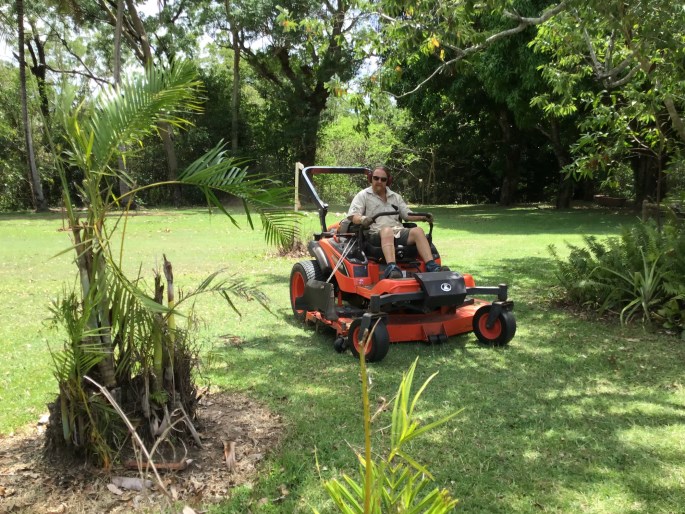
Monthly jobs are minor, & like other tasks are kept in the diary to aid our memories. We keep the public rubbish tip tidy, its by the side of the road 2 or 3 kilometres south of us, so it will only be possible until the water comes over the bridge. It doesn’t take much, & has often been an excuse whilst up there to go exploring along a nearby forest track into the Batavia forest reserve, aboriginal country that we have permission to go on. There is a lovely little permanent lagoon where we have seen a variety of birds & further in there is a pleasant sandy beach on a large bend of the Wenlock.
We also read & re-set a road counter monthly & feedback the info to the Cook Shire Council & we have two fruit fly traps here which the contents get emptied monthly to be sent to
the Government Biosecurity Queensland department as part of Australia’s first line defences against invasive species from Papua New Guinea & the traps re-set. (Pink Job). Again procedures which seem much smaller once we had done them the first time. Housekeeping & gardening as required. This week MrsTea has been redistributing a lot of lily bulbs, thinning out thick clumps & planting into areas she first cleared of weeds. My ‘gardening’ is in the form of spraying herbicide where required.
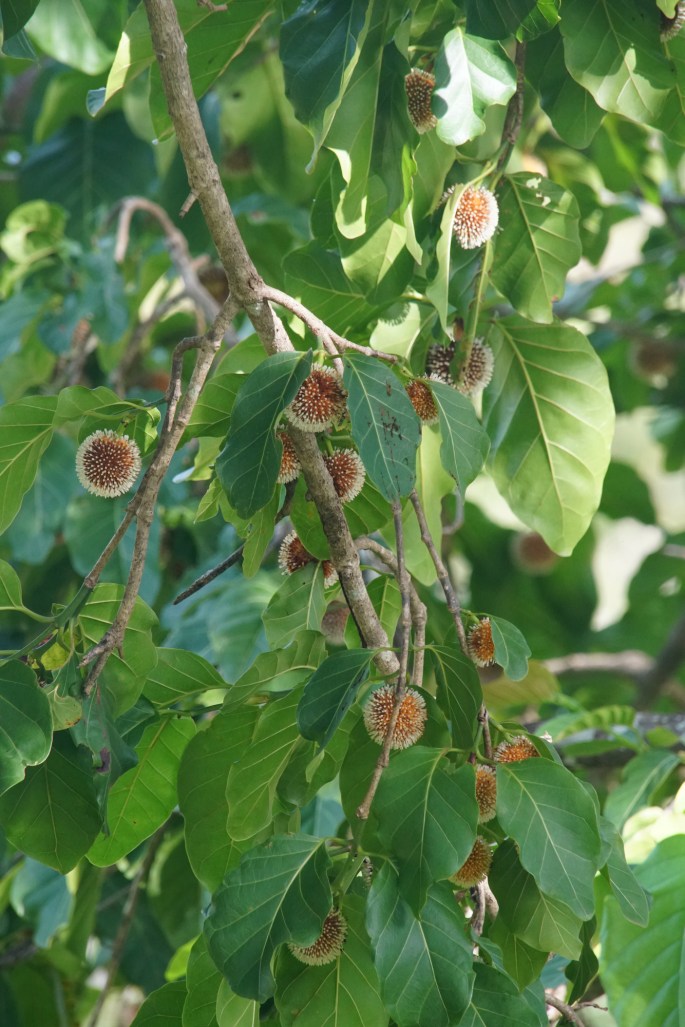


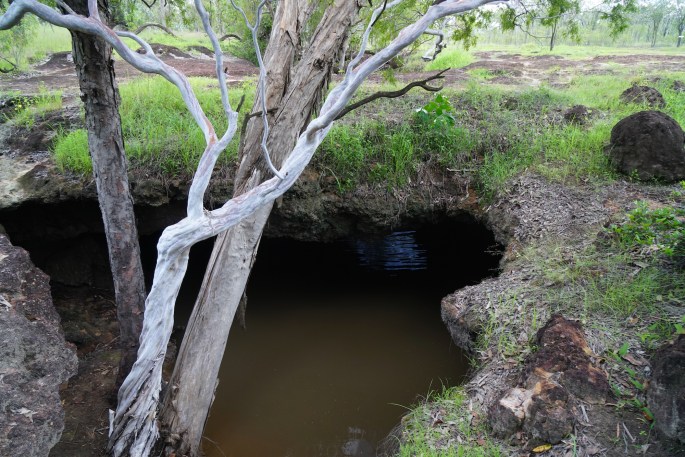



To get around the property & local area we have the choice of several vehicles. Most used are two ageing Suzuki quads. They are practical & fun, but have needed a little fettling & repairing to keep them running. The ‘Old Faithful’ Moreton Ute is a Toyota Landcruiser with a ‘can’t kill it’ 1Hz inline 6 cylinder non turbo diesel motor. Same as we had on a Troopy we once owned. Still the nicest motor in any vehicle off road that I have ever driven. MrsTea rather enjoys driving it too. Then there is a fairly new off road Honda motorcycle which plays second fiddle to the quads, I seem to find throwing a leg over it’s tallish seat harder than I remember it used to be, & standing up on the pegs hard on my knackered knees, but it’s handy now & again when nothing else needs to be carried, & finally there is the 4 seater golf cart, powered by a horizontally opposed twin cylinder petrol motor & simplified controls for golfers. Not very nice to drive & only gets driven to keep the engine & battery alive now & again.

It is now second nature for us each always carry a UHF radio whenever we leave the house. It saves an enormous amount of ’to-ing & fro-ing’, & is a sensible safety measure. We each feel more comfortable when the other is contactable, in case of accident, snake bite or whatever. To date the most serious has only been a Quad breakdown requiring a tow back to the workshop to fix but we have become accustomed to talking to each other on the radio without feeling self conscious & I have overcome my compulsive urge to say things like 10-4 Rubber duck …. whatever that actually means. Like other stations we have been to the UHF brand here is Icom. Same as we have in our car. The handhelds are rechargeable & very solid units which have survived both being dropped & rattling around among tools in the boxes on the front of the quads.

The week prior to Mike, Wendy & seasonal staff leaving was a busy one once the decision to ‘close the gate’ had been made. Lots of wet season preparations & the flood preparations. Safari tents dismantled & stored away in containers, bedding etc stored away in the other main building – the guest house, water pumps which supply the guest house & the Outback Spirit camp removed from the river in addition to the various preparations for folk moving out & us moving in. And then there was the flood preparation. Anything not needed moved to high(er) ground out of harms way, or packed away in a manner which prevents them being washed away. Essential equipment not upstairs in the house where we live, Fridges, freezers, washing machine etc raised up on tables, sawing horses etc in the hope of keeping them above flood level. It is a gamble. Flooding is fairly likely but precautions taken are for ‘average’ flooding conditions. If we get a big one the precautions won’t have been enough.
As mentioned we maintain a daily record of river heights. To date the highest level since we arrived has been 3.5 metres. The bridge goes under & cuts the road at 6.5 metres. Flooding of the property begins at 13.5 metres. The picture below taken by the caretaker who was here in 2019 (Drew) shows the view from the front of the house when the river rose to around 15 metres. Some years it has been higher. The precautions taken to raise things off the ground (underneath the house & in the workshop) would cope with a flood like 2019, but not a higher one. We have a boat here with an outboard motor which after a recent ‘false alarm’ when we thought we heading into a flooding event (but weren’t) is parked under the awning at the front of the house, & tied to the house to stop it floating away. During a flood the house literally becomes an island, & the boat is needed to reach the generator to re-fuel it, & to get to the airstrip when needed. At 13.5 metres river level water starts inundating the property via the front gate, by the time it is as shown in the picture it has completely broken it’s banks & we are then ‘in the river’. When it is like that wading or swimming can be risky. In 2019 a crocodile was observed swimming under the house! Flood waters generally dissipate within a day or three. It really is hard to imagine the immense amount of water that is needed to create such flooding, or even just to fill the Wenlock’s main channel. However we knew the score before taking on the caretaking role, & in many ways look forward to the ‘excitement’ of it. In some ways it will probably be ’shit’, but it will be one heck of a memory & a good future story to tell. It is also possible we may not get a flood, but if truth be told I think we’d be a little disappointed!

The advice given to us was to remove the third river pump (supplying the house) when the water level rose to 2.7 metres. For the first couple of months it sat under 2.2m, but after a couple of heavy & exciting thunderstorms it had risen to 2.5m one morning when checked at around 8am. Even that sort of rise had transformed the crystal clear gently flowing river to a muddy fast flowing & significantly wider river. Sandbanks & rocks that we were familiar with could no longer be seen & it looked like a completely different river. It was different & a bit exciting, but our expectation was that the level would fall again as the rain events of the past two days were over & no more forecast. At 11am I thought I should check ‘just in case’, & found the level had risen to 2.9m & as best I could tell was still rising. Panic stations – well not exactly ‘panic’, ‘action stations’ perhaps, a realisation that ’now was the time to act. Tools were quickly gathered & disconnected the water lines & power supply & got the submersible pump, hung from a tree, out of the river just in time & retrieved it to safety. An hour later with the water having risen further retrieving it would not have been possible without entering the fast running water. Phew! Nevertheless, as we expected water levels peaked at just below 3 metres & then dropped over a couple of days, but we have relied on rainwater since, no point putting the pump back into the river now as it continues to be muddy and the sediment would only block the house filters.
Not long after that the possibility of a cyclone occuring became a subject of excited discussion among online weather watchers, about 10 days before it became a reality. A variety of weather models predicted large amounts of rain to fall in the the Wenlock catchment, as much as 500mm according to some. As the time got closer the models began to increasingly agree with each, but the amount predicted in the catchment dropped to 300mm. The rise observed with the water pump event had been onto dry country & a total of around 100mm over several days. The falls predicted with the cyclone were not only a lot higher, but the ground was already wet. I’m sure you can see where this is leading …….We thought we were at risk of a significant flooding event, & perhaps we would have been if the Cyclone had not passed us well to the east before crossing the Cape a fair distance south of us & we didn’t get a drop of rain, nor a breath of wind from it. Once again our anti-cyclone superpowers saved the day. We once heard stories of aboriginal tribesmen warding off an approaching cyclone standing on a beach & pointing spears at it. Our mere presence seems to be enough. Someone should employ us as ‘cyclone protectors;. 🙂 We had a very busy day though, getting the boat to the house, moving all vehicles , tractor & mower to higher ground & making last minute plans to ensure easy availability of fuel for the generator, & boat. It was a ‘dry run’ literally, but good practice I suppose. Later when talking to Mike he reassured us we had acted appropriately but then went on to say that flooding was far more likely in February or March, & the time to ‘act’ would be once the bridge goes under, with a follow up of daily rainfall in the catchment over a number of days, but also that it is possible that when it does come right up it can do so very quickly in just a few hours.
As expected, the weather has been hot & humid, once again we are used to wet clothing. We don’t think the humidity is quite as ‘full on’ as we experienced at Goombaragin, north of Broome 3 years ago (how time flies!) but perhaps it is just more familiar to us now. Our bedroom air conditioning is set on 25 deg.C & walking out of the bedroom still feels like walking into a sauna. Ceiling fans run 24/7, as do floor mounted fans dotted around & below the house, many aimed at the motors of fridges & freezers to aid their cooling. The Tvan is stored up above flood levels (hopefully), shut up with lots of calcium chloride crystals to absorb moisture. We have only needed to empty the water it has pulled out of the air & replenish the crystals once so far, testament to the Tvan’s air tightness. The Patrol is a different matter though. For a couple of months we had it parked under cover, with the cab windows open to allow breezes to blow through which worked ok, but then over the course of 24 hours both of the canvas seat covers developed a thick growth of green mould. We brushed the mould off & agonised whether to turn the the Patrol into a fish & chip parlour impersonator with the use of vinegar to deter the mould from returning. Feeling that the moisture from the vinegar may create as much problem as it solved, we instead put two buckets of calcium chloride inside the cab, one for each seat, as well as a 240v fan running all the time. After several weeks it seems to be working, the mould has not returned, but the amount of calcium chloride that has been needed, replaced several times & perhaps as much as a couple of litres of water removed from the cabin’s air shows just how humid it is. The cheap & not completely trustworth digital hygrometer/thermometer here shows daily temps of around 38 degrees.C (max of 40.1) & humidity varying between 45% & 95%, with the higher figure in the early mornings, 6am to 7am when the ambient temp outside is around 24 to 25 degrees. 95% at 38 degrees would be horrendous, but so far so good. When it rains the cooling effect is gorgeous, but it is short lived. The ground dries, releasing it’s moisture into the air & the humidity rises steeply. Underneath the house the floorboards of the ’20 degree supermarket bedroom’ drip with condensation whilst the rest remain dry.
The rains, which although not daily (yet) have increased since new year & with that we are seeing more fungi popping up around the place, from tiny & delicate to giant. We expect that if/when the monsoon kicks in proper we’ll see a lot more.




Up until the first rains arrived in great northern style – sudden, heavy & with great rolling thunder & exciting lightning shows, the house had been surrounded by feral cattle each night who made themselves at home, having come out of the bush, lured by the heavy crops of mangos on the huge old mango trees dotted throughout the campgrounds. The shade the trees offer campers during the season, being desirable to numerous bulls, cows & calves too. As many as 40 head, bulls bellowing at each other, cows calling their calves & calves calling their mums. Add in the manic after dark screaming of the Bush-Stone curlews & night time at Moreton was far from quiet & peaceful. We were told the cattle would leave once it rained as feed out in the forest would increase dramatically. What we hadn’t expected was that this would happen so quickly. The morning after the first rain on 13th November there was silence (relatively, discounting the frogs & the insects which can also be quite noisy after rain). All the cattle had gone & did not return that night. We puzzled over this. Grass doesn’t grow that quickly, not even in the tropics. And then we realised that the raucous sqwawking of the Sulphur Crested Cockatoos was absent & put two & two together. The cattle have learned that the Cockies are wasteful birds. They get into the mangos, but drop most of them onto the ground & the cattle know that cockies in the trees above means delicious mango tucker below. When the trees were all but emptied of fruit, the cockies stopped coming & the cattle left. We saw no cattle here again until the new year, & now we get the odd couple of bulls or a very small family group, but thats all, & they maintain a respectful distance from the house, whereas previously we had to spend time ‘fortifying’ the fences around the house to keep them out of the house garden.

Now we get other visitors. Wild pigs are around in large numbers judging by the amount of digging we see, but they are not like cattle, they take off at the first sight of humans. There is a big old boar, all black (as most are) except for his white front legs. We’ve seen him alone crossing the grass, between the forest & the river a few times, and on one single occasion saw a single smallish pig out in the middle of the grass. At the time this seemed a little odd, but with binoculars located a whole ‘tribe’ of them just within the tree line, all quite sizeable animals. we counted 17! Either we sleep deeply or they know to be very quiet when close to the house. We awoke one morning to find extensive digging around every fruit tree next to the house, as well as under all the mango trees further afield. Initially we blamed ‘Manuel’ one of the several Brush-turkeys who have their huge mound nests along the top of the river bank, but quickly realised that the digging & pulling up of sizeable roots was more than he & his mates could manage. Mind you he is no innocent bystander. When he’s not chasing the women about or adding to his mound he’s a bit of a mischief maker. An unopened packet of marshmallows sitting on top of the covered billiard table downstairs was his first target. Caught red handed (red beaked?) he tried to make off with the entire packet but was foiled in his attempt by MrsTea. Then there was the Water Melon Affair. Trudy, visiting from a station further south at Lakeland where they grow these delicious seedless melons had brought us one as a gift. Manuel didn’t take long to find it, making a hole 5” deep into it. Thankfully we rescued it before he could get more. Next was the tube of contact adhesive. Unopened until he pecked a hole in it. Fortunately or unfortunately depending upon one’s point of view he did not glue his bill shut & suffered no ill effects. A few days later a package of black plastic dustbin liners were spread all around the lawn, but he’s been good since then, spending a bit more time tending his mound. We think they must have eggs in there. Amazing bird really. The eggs are hatched using the composting heat of the mound, constantly kept at the correct temperature by adding/removing material, & when the eggs hatch the young are self sufficient from day one. No parental guidance whatsoever. Maybe that’s why they are bastards! The other bastards around here are worse. Green ants. Nasty nippy little buggers. They swarm on the garden gates waiting for an unsuspecting arm to run up, from which position they can mount wave after wave of attacks on the victim. Their sense of timing is immaculate. It’s always when you finally think you’ve got the last of them off you that the next wave comes.
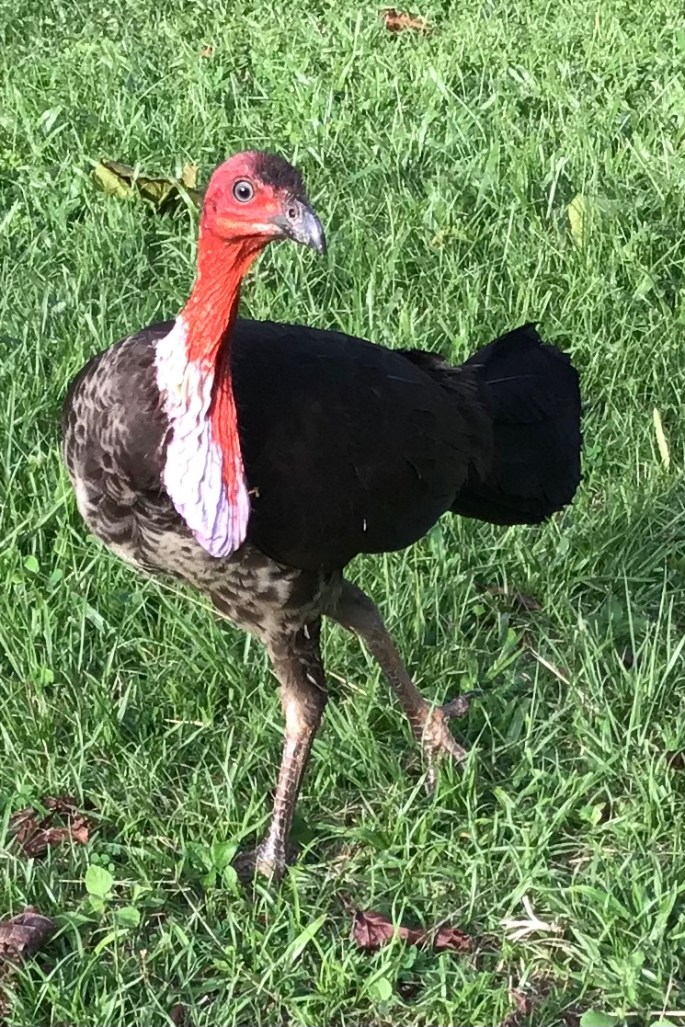
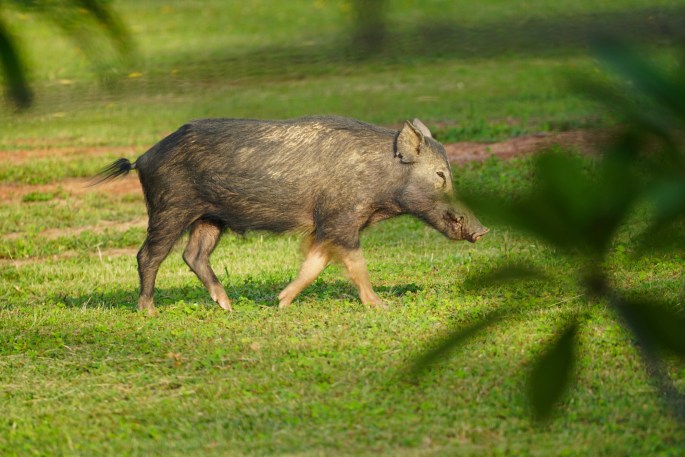
A couple of small north western Carpet Pythons have been interesting visitors along with a couple of Keelbacks. One python took up residence downstairs on a joist in a location between a couple of empty meat pie boxes for a while, & another (or possibly the same one) joined us in the kitchen one evening, curling up & observing us from on top of an open outside door . When the door needed to be shut at ‘mozzie o’clock’ MrsTea did the honours & took it out into the garden. The Keelbacks, both the less common northern black type are good snakes to have around. They are one of the very few that are not affected by Cane Toad toxin, so help to keep the Cane toad population down. Keelbacks are not deemed to be dangerous, but are reputed to give off a foul odour if upset. I posted that on Facebook & a friend responded “Rather like me then”. 😀
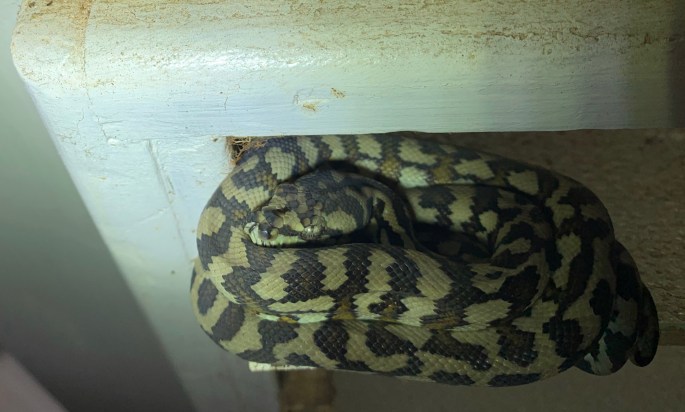

Frill necked Lizards are not common, but they are around. I’ve seen half a dozen, but never a real good view, nor with their frills up in the dramatic way that photos always display them & viewings are always brief as they are such fast critters. Can’t help but smile at their 2 legged running style.
Since we closed to the public the wallabies have been more common, not in large numbers but always around. None of the rarer Antilopine Wallabies said to live around here yet though.

Living with geckoes throughout the house is standard in the tropics, but because they are so common , they rarely get a mention, but there is never one far away.
In the early hours one morning recently we were both awoken by what was obviously the sound of howling dingo pups. Early in our time here I had seen a lone dingo across the grass at the forest’s edge, so knew they were around. This howling was much closer though, very close, possibly underneath our bedroom or out in the garden. MrsTea, keen to investigate went out to the kitchen door & looked into the garden still hearing them for a short time, but unable to determine where they were. Shortly after opening the door they went quiet, but a very short time later we heard an adult howling about what we estimated to be 70 or 80 metres from the house in the nearby trees. Then quietness. We think the youngun’s were out & about exploring their territory, ‘off the leash’ as it were until mum or dad called them back. We had in days previous seen large & small ‘dog’ tracks on the wet ground up on the track to the air strip. Just a few days after the visit from the pups, MrsTea was up at the airstrip, riding one of the quads. Having the sense she was being watched she looked behind her to see a large healthy looking dingo, about 7 metres away. It was watching her curiously, as dingoes do, but she was a little frightened wondering if it’s size & obvious health resulted from it taking large prey & considering that she may be on the menu. She called me on the radio, telling me what was happening. She turned the quad around to face it & drove toward it, trying to frighten it off, but it just moved around to behind her again. I think she may have been telling it to leave, and it did go, of it’s own accord it walked casually off into the nearby bush, & I got a further call telling me not to bother coming as it had gone. Boy was I disappointed. MrsTea who one might be forgiven for thinking she would be relieved had quickly processed the situation & realised that she was in no danger, & that the dingo was simply curious. It would be lovely to see the whole family together. We have a rough idea of the area of bush where their den must be, so will keep our fingers crossed that they show themselves.
We are keeping a list of birds seen here, 49 species so far, but 2 have for us been extra special. Not only have we finally seen Magnificent Riflebirds, beautiful birds we heard frequently in the Iron Range Rainforest near Lockhart River, but never saw, but we have also had three visits from Palm Cockatoos. Their first visit was a ‘reccy’, three of them flying around, calling out to each other, but only ever landing at a distance. Seeing them like this was wonderful, but I wanted more, I wanted them closer where I could photograph them. We deduced that they were checking out the fruit on the Leichhardt tree in the garden & hoped they would return to feed. Next morning, whilst still in bed we heard them & I was up like a shot, grabbing camera & shoes on my way out to them. It wasn’t the Leichhardt they were interested in , rather it was the nuts on the Beach Almond tree, close by, that we hadn’t even realised were there. Mum, dad & young one. These are an endangered species, who pair for life (lifespan similar to humans) & who only breed when conditions are right, laying just a single egg, sometimes only once in 10 years, & they are endangered due to the impact of humans upon their environment, so having a pair with a young one who had clearly survived & not been eaten by a goanna whilst still in the egg alongside our house was very special. What was better was that the attraction of one of their favourite foods was such that they took no notice of the naked cameraman below them. A couple of weeks later we had another visit from, we think, an older bird, alone, who similarly spent a fair bit of time in & around the same tree cleaning up the nuts left by the others. Again he took little notice of me, even though I had dressed for him!
‘Kookie’ was a self inflicted unwanted visitor. MrsTea had taken to feeding the several laughing Kookaburras who hang out around our garden. Finding one of them inside the house, perched on a hanging fluorescent strip light was a pleasant surprise, but it’s efforts to find it’s way out were distressing to both it & to me when it kept trying to leave by windows covered by flywire. Eventually it found the open door. She now feeds them on top of an old tree stump in the garden, away from any entrance to the house
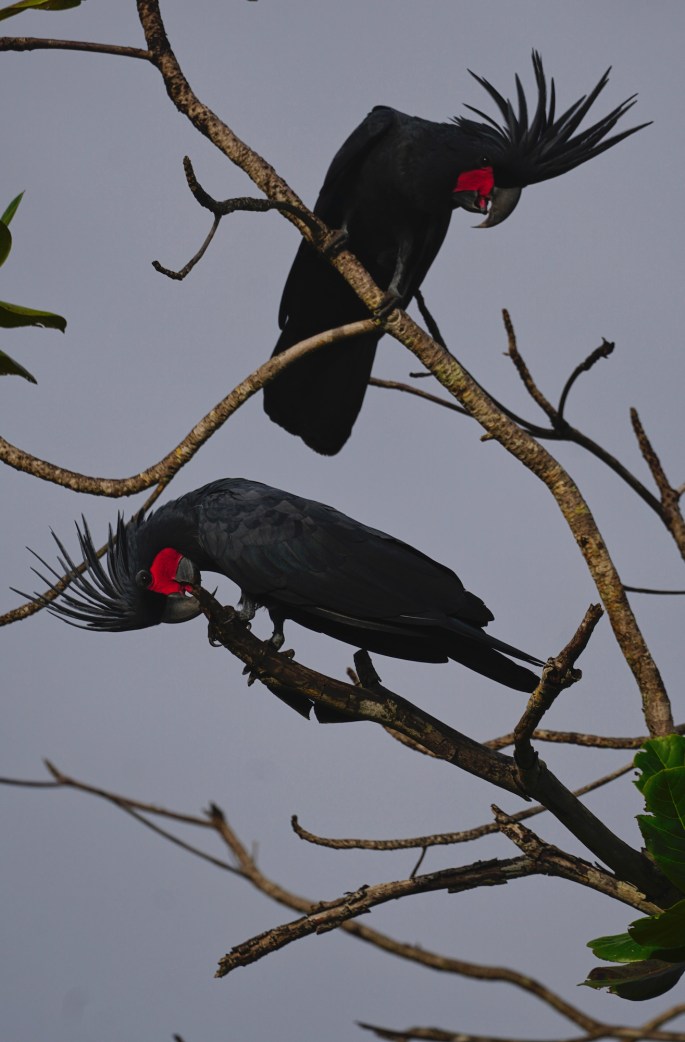
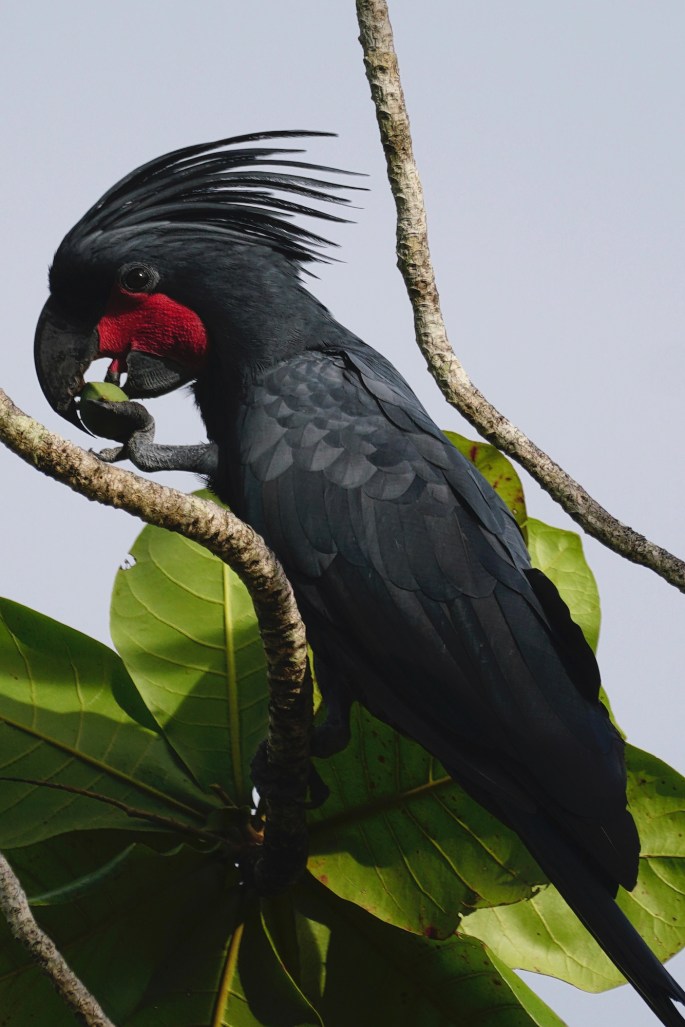

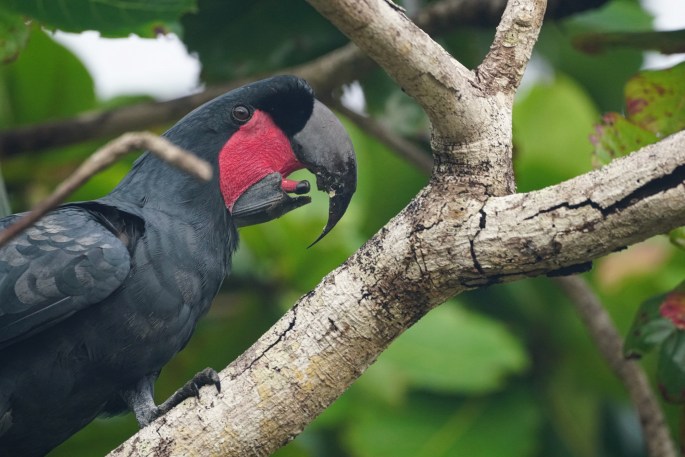
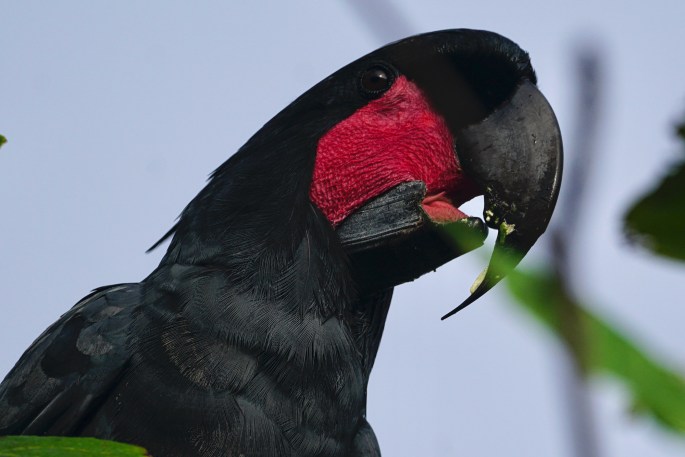
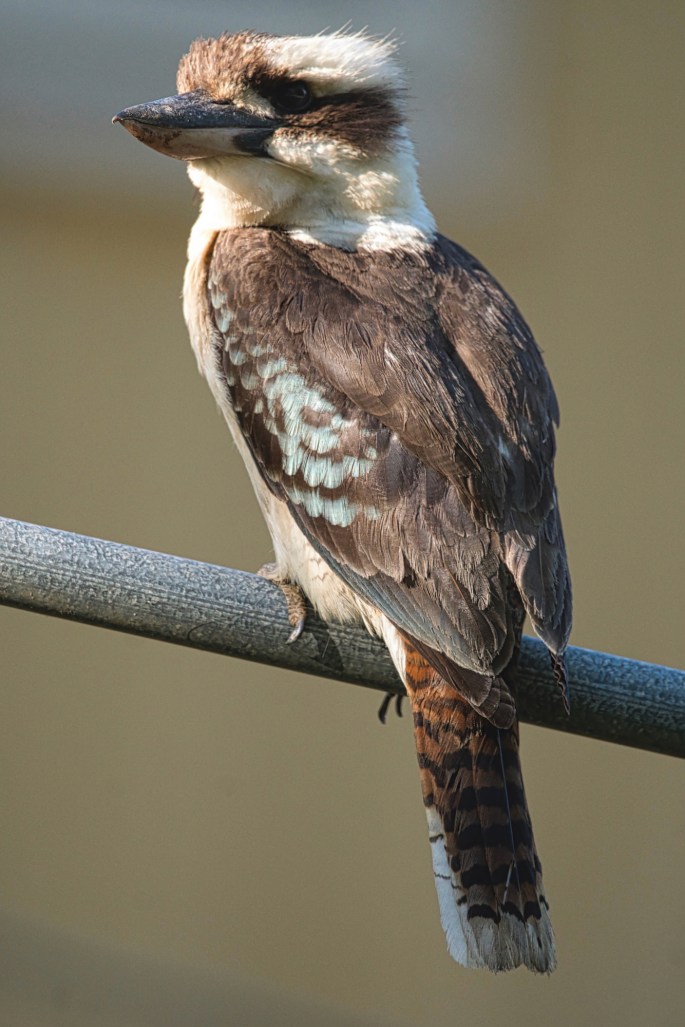

Readers may be surprised, as we were, at the number of human visitors we received prior to Christmas given our remote location. After the owners left two consecutive days was the longest we went without someone turning up. All sorts. The two most notable were the young east European couple on a pair of state of the art lightweight recumbent tricycles, riding them up to the Tip. The front gate was shut, with a closed sign & it was dark, around 9:30pm. We were getting ready for bed, but the lights in the house were still on. “Hello-o. Hello-o” came a call out of the dark. Very strange, a little disconcerting even, particularly as we had heard no vehicle arrive. The young fellow had just arrived at the area near the bridge, often used by folk to camp, & asked politely if I could give him some water. I guess he wasn’t game to take it from the river where he had left his girlfriend. Whilst showing him where he could fill his water bottles he asked if I could help to repair his girlfriend’s trike & was pleased when I suggested they return in the morning. It turned out that a crucial weld on the ultra light titanium frame had broken on the corrugations. I assured them that the chances of finding a specialist welder to repair the thin wall titanium tube on the Cape were zero. The broken weld not only formed a stressed part of the frame, but also held the mounting for overhead solar panels to provide power for a pedal assist electric motor. His bike didn’t have this, but his girlfriend was pessimistic & talking of somehow getting to Weipa & getting the trikes & themselves flown home to Cairns. He however was not ready to give up. A variety of ideas were tossed around regarding repairs. It seemed clear that she did not share his optimism, & at risk of putting my foot in mouth, I understood why. His suggestions seemed based more upon wishful thinking than on any mechanical principles to me. Trying to say so without offending saw her begin to treat me & not him as the repair expert, not something I felt especially comfortable with, but one way & another I managed to get us all onside together & working toward what I considered a possible fix, using lots of tie wire & zip ties. A hoped for improvement on his attempts with tape. We reached a point where the machine was significantly more rigid & promised to work, & her optimism had increased to the point that she now thought giving it a go was worth a try. A week or ten days later I saw a photo of them at Seisia in the Cape York Times. They made it!
Another little adventure was the recovery of Lana’s car. She lives in the isolated bush community at Wattle Hills, not really that far away but only accessible by a 4wd track with creek crossings & steep gullies along the way. The track only useable during the dry season, & a three+ hour drive to do the 60 or 70kms from here. A number of weeks earlier she had the misfortune to lose the use of the gearbox in her Toyota Troopy just as she was near the top of a steep rocky climb out of a gully. With suddenly no drive she had nothing to prevent her rolling backwards which ended with her rolling the car on to it’s side. She sustained no serious injury & was able to use her satellite phone to call for help to folk who had driven out to pick her up….. but the car remained where it was, albeit somehow having been put back onto it’s wheels. During a visit here she had sounded me out about my willingness to help her go out to recover the vehicle. Up here folk rarely ask for help, & when they do they are unlikely to ask a second time. Feeling that a positive response would be unlikely to be forgotten together with the opportunity to check out what some folk had described as a fairly gnarly track I’d said “Yes”. Lana owns a second similar Troopy & this was to be the tow vehicle. She considered who might drive & who might be towed & asked me to take the wheel of the towed vehicle. “The engine still runs so you’ll have brakes AND aircon” she said grinning. The drive, a couple of hours into the bush, revealed that she knew the track well & by the time we reached the car I had no qualms about the task ahead. As we had been driving I was assessing each obstacle with the thought “Would I pull our Tvan through here with our car” & by the time we got there had not found anywhere to which I would answer ‘No”. The gnarly track, whilst not a walk in the park, was less gnarly than I had expected. Apparently closer to the community the track gets a bit hairier in places, but that wasn’t where we were taking her car. The idea was to get it back to the road near Moreton, & then down to Picaninny Plains Station, where it would be left until she could arrange to get it to a mechanic at Lockhart River. First though we had to get the car pointing the right way. A ‘three point turn’ was accomplished between the trees first using the winch on the stricken car & then a tow strap attached to the second car. We each had a UHF radio so could talk to each other at every obstacle & we soon established a good trusting relationship & really the whole process was easier than I think either of us imagined it might have been. Back out on the road we called into Moreton to assure MrsTea (who had been in heaven spending her time looking after Lana’s gorgeous hound) that we were both still in one piece, before continuing on to Picaninny, about 70kms south. Sitting on the end of a shortish tow strap, unable to see the brake lights of the tow car because of the dust, at speeds up to 70kph was an experience! I took to swinging from one side to another , much as as water skiers often do behind boats when they want to build up speed. Lana would tell me if any vehicles were approaching on the UHF.
We have met a few others of our neighbours, others from Wattle Hills & from other stations. As in other places, we are not ‘in each other’s pockets, but like in other places we enjoy becoming ‘known’ & knowing that if we ever were in need of help there would be folk there for us, albeit our nearest neighbours are an hour’s drive from us. The more we get to know folk, the more it is apparent what a small community the Cape is. Not unusual to have a conversation & have others we know in common, even if they live a days drive or more away.
And so we have had another Christmas on the road, our 4th I think. Here we had no Christmas decorations bar a little tinsel but in her own way MrsTea did us proud. Couldn’t expect any more from someone who once attended a fancy dress party dressed as a carrot! I think you will be impressed by our traffic cone Christmas tree with it’d duster angel! And I’m certain that you cannot fail to be impressed with Christmas dinner ingenuity! We had a good laugh. The video is her at her best. I love her & expect you will too. Fireflies provided us with natural Christmas flashing lights around the house, although not on the ‘tree’.


We do get a lot of phone calls. These fall into two categories. “Can we book a campsite for 1 night next June/July/August”. These have been a constant since we arrived. “No” is the answer “Just rock up, there’s plenty of room”. And then there is the equally common “Is the Wenlock up, can we get across the river” Sometimes we feel tempted to tell folk to look on the Bureau of Meterology website, but never do, ‘but instead often end up having a broader conversation. Folk heading south from Bamaga, folk wanting to get up to Bamaga from Cairns or Weipa, but most common are concerned relatives of “Young Freddy who left early this morning , but we haven’t heard from him yet, is he likely to be stuck at the river near you”. Sometimes late at night & even with requests that we go out to the bridge & check to make sure Young Freddy isn’t there.
One call which was a little different was from the Army, asking if it would be ok with us if they could land a Chinook helicopter on our airstrip. They wanted to land, drop a few soldiers who would run around in a warlike manner for a short time & then get back in the chopper & leave. Which is what they did. We think the running around on the ground was probably more for our photographic benefit than any genuine training, but it made for an interesting morning. They provided us with an ETA & we sat in the ute at the airstrip & observed. I guess it’s not everyone who gets a Chinook
landing in their backyard.

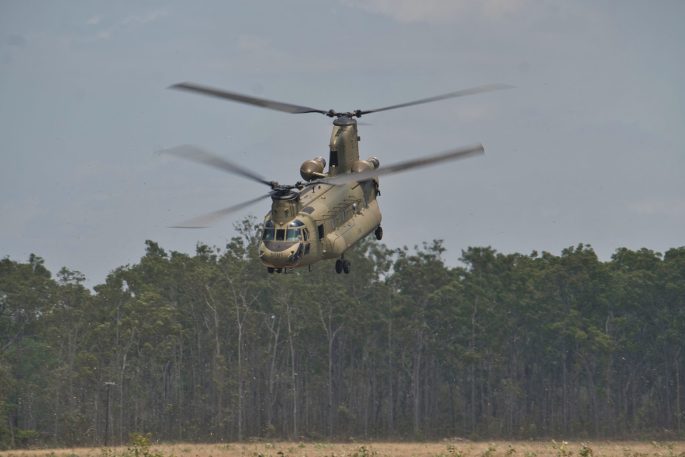
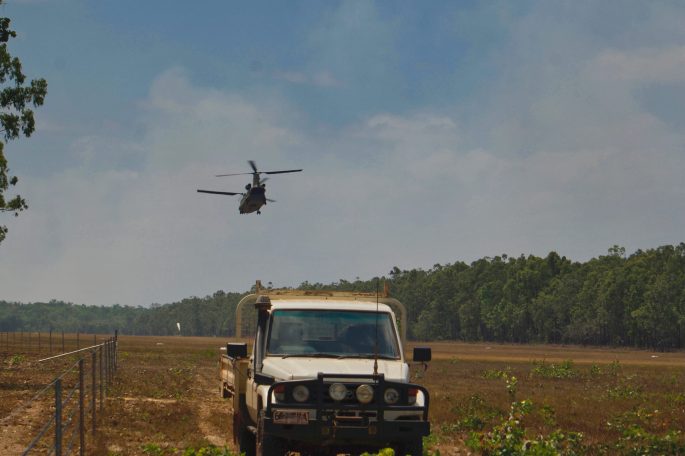
And now finally for this post a bit of news as we posted to our friends on Facebook a short time ago.
Once again we are pinching ourselves at our good fortune. Each time a desirable opportunity arises to have a more ‘in-depth experience’ that cannot be had by travelling alone, it serves to confirm the gut feeling we had when we commenced travelling, that taking our time & travelling slowly would flush out such opportunities & we have no reason to pass them by as we don’t have to be anywhere at any time.
We had been thinking of leaving the Cape at the end of this wet season, possibly heading west to Arnhem Land, but an opportunity that few nature lovers would ever get has arisen & we have grabbed it.
We have accepted a 12 month caretaking role at the Iron Range Research Station confirmed for when we finish up here at Moreton at the end of the wet season (Most likely sometime in April or May). https://www.maximfoundation.org/irrs
We certainly never set out to do any house sits/caretaking gigs back to back, nor to seek anything for as long as a year, but when an opportunity to live hidden away in the middle of one of the richest flora & fauna hotspots in Australia arose, we couldn’t say no. We will be living in a modern off grid house surrounded by 800 acres of privately owned rainforest, which in turn is surrounded by the entire Iron Range rainforest. (Think ‘tropical jungle’).
Previously we have spent periods living near the Iron Range rainforest & day visiting, but expect to see far more living right in it.
Much of the time we’ll be there alone, but will get occasional visits from an assortment of researchers & ecologists who want to study specific aspects of this unique and ultra diverse ecosystem for a week or two at a time.
Accomodation is essentially 2 modern self contained houses with a shared outside undercover ‘tropical kitchen’ with a sealed food storage room, plus a few other storage buildings. Us in one house , visitors in the other.
Although not far from Lockhart River Community the place is completely hidden away & can’t be seen from any road , nor found on satellite imagery.
The ‘job’ shouldn’t be too arduous or time consuming & is essentially voluntary, although we will have our living expenses covered making our stay there ‘cost neutral’, plus all utilities & satellite internet included.
Already knowing a few people in the area & being familiar with the community & it’s resources will make for an easy transition.
So we will be remaining on the Cape until mid 2023 now.
Woohoo!
Thanks for reading, we hope you found it enjoyable & of interest
All the best
Cuppa & MrsTea.


Great read. A little younger and I’d apply. Stayed at Moreton last year on way back from The Tip. Went spotlighting for cuscus with our friends. Don’t mind the heat and humidity during day – just need some AC at night in bedroom.
I must admit it was nice to walk into a cool bedroom there.
Thanks for sharing, a wonderful blog.
Thanks for the great read and all the photo’s , what a great time you have had. I look forward to hearing about your upcoming adventures in your next slice of heaven.
Your posts are absolutely fantastic. A far cry from rural Victoria. I love how you grab life at every opportunity and enjoy every aspect, convenient and inconvenient. Keep up the posts so us armchair travellers can get excited about the possibilities. Cheers Janet and Stephen xx
Great read .Are there still spotted cuscus in the mango trees.? Saw them there years ago, before the Wenlock bridge was built. Had always wanted to see one and finally got lucky
We are told they are here Graham, but as yet haven’t seen any.
You’re having a ball Cuppa and Julie! I loved reading your blog and hope to see you soon!
What a magic experience and thank you for sharing with us. We have spent some time at Moreton about 6 years ago and your story brings back such fond memories !!!
No doubt about you Cuppa you certainly have a way with words another great read
Another great read. Have stopped twice at Moreton – once in 2011 and again in 2018 so could relate to much of what you wrote about. Heading back to the Cape for yet another ‘explore’ of Lakefield NP later in the year (Covid dependent) and your blog entry has reminded us of why we love that part of the country. Our departure can’t come soon enough.
What a wonderful time you’ve had and what a joyful time I just had reading about your latest exploitsThanks so much for sharing.
Good to see all is well with both of you.
Hi Cuppa and Mrs T.
A great story and photography. Well, your life has really turned into a wealth of unique experiences which you have shared with many others. This is no easy task and much appreciated. All the best from Doug and Jackie in Cobram on the Murray River.
Great story from a wonderful place; we first visited in 1984 on the trip north and then again in ‘87 and ‘02. We’re now at the stage of looking to do something similar in the future.
Wonderful clip of life in the York. I will post on our BONZA facebook site- hope that is ok https://www.facebook.com/BonzaBabyboomersOfNewZealandAndAustralia
The best report yet! We love your part of the world. Your details make it come alive.
Thank you for your detailed and informative article. We travelled to Cape York from Melbourne in 2016 and dropped in at Moreton on the way down. We would love to visit again. Still working in our mid 60s. Take care
Great write-up again and so vivid in your descriptions. Congrats on the new gig at Iron Range Research Station. Looking forward to the next instalment.
Most interesting and very well written. A book of all your trip should be published.